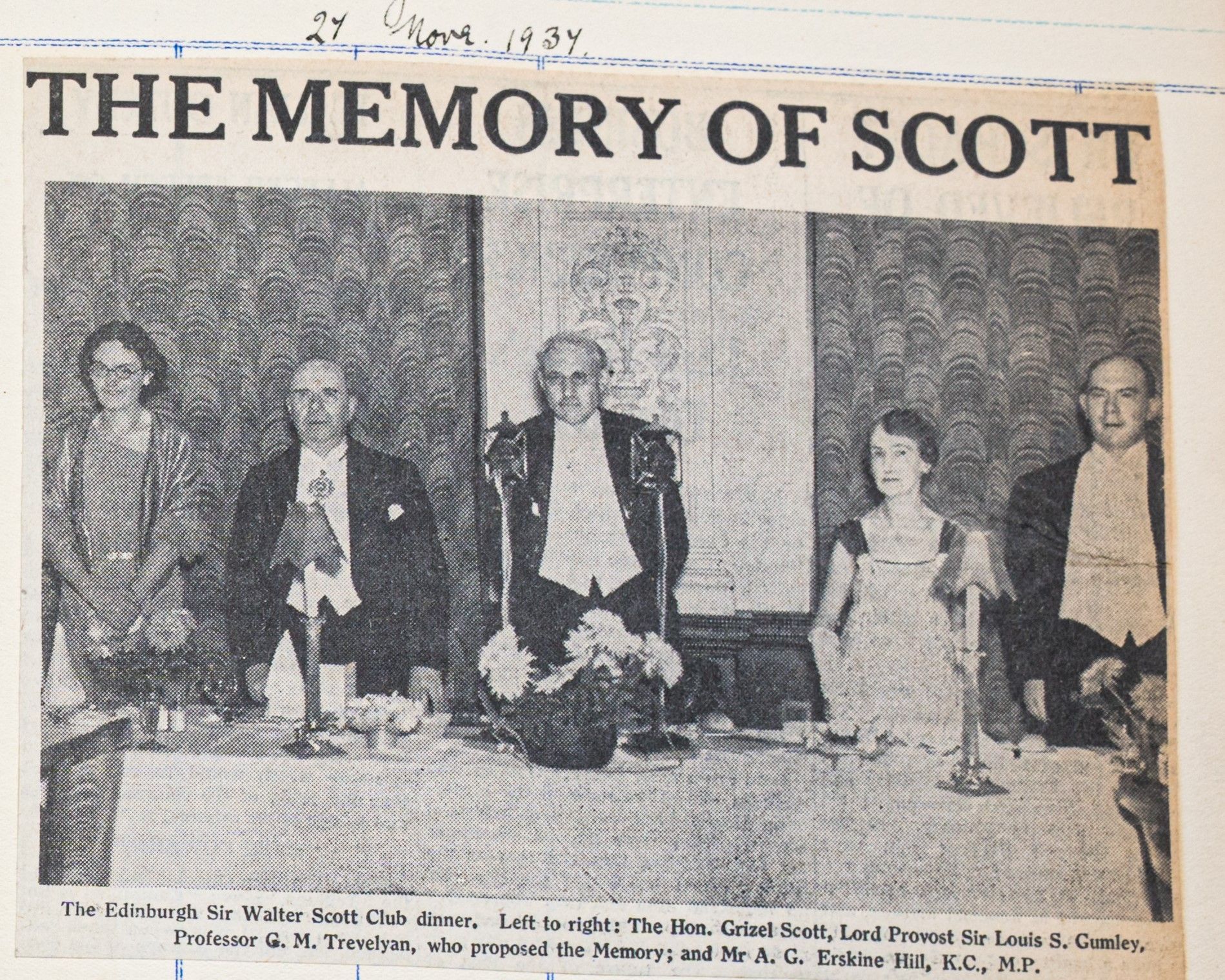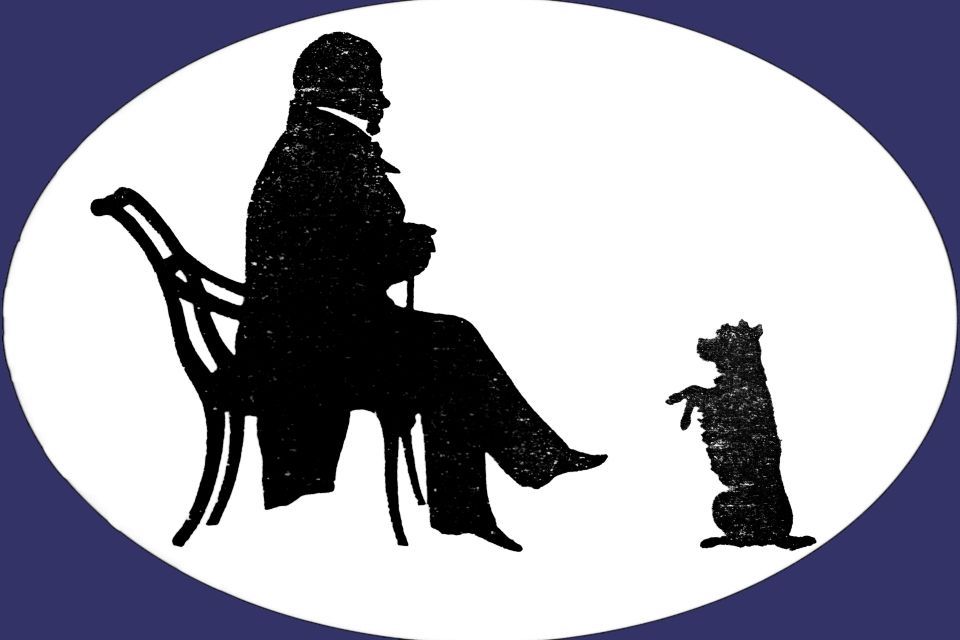1936
Our President in 1936 was:
Dr. James Curle
He proposed the Toast to Sir Walter at our 37th Annual Dinner on Friday 27th November 1936 in The North British Station Hotel
Download the [transcript] or read the [bulletin]
Summary of the Speech:
Dr. Curle opened with a tribute to the recently deceased Sir Robert Rait, who was originally meant to chair the dinner. He expressed his gratitude for being made President and emphasised the Club’s tradition of celebrating Scott annually since 1894. Rather than offering a critical analysis, he gave a heartfelt, vivid portrait of Scott's early life, influences, character, and genius.
Curle focused on:
- Scott's Border roots, early love of ballads and storytelling, and the lively oral culture that shaped him.
- His precocious childhood, remarkable memory, and early literary interests, from Bible tales to romances.
- The richness of Scott’s legal and social environment, providing inspiration for his novels.
- His love for the Scottish countryside and deep historical knowledge, seen through Abbotsford’s construction and his ballad-hunting adventures.
- The breadth of Scott’s novels, covering all social classes with historic depth, and their enduring power despite changing literary tastes.
- Scott’s personal values — loyalty, courage in adversity (especially during his financial crash), humour, compassion, and tireless literary efforts.
- The declining modern readership of Scott, but a confident assertion that true lovers of literature will always treasure his legacy.
Interesting Points Worth Highlighting:
- Scott’s Childhood Recitations: At four years old, he was already declaiming long ballads like Hardykneute with great passion—even while receiving electrical treatment for his lame leg.
- Deep Early Memory: An eyewitness account (Mrs. Cockburn) reported him at age six discussing Milton and calling himself a "virtuoso"—one who “wishes and will know everything.”
- Scott’s Learning from Everyday People: He had a unique ability to absorb phrases, stories, and characters from ordinary folk, enriching the authenticity of his novels. His court work and travels on mail coaches are cited as endless sources of inspiration.
- Abbotsford House: Dr. Curle provides a vivid description of how Abbotsford grew chaotically into an architectural mixture, filled with relics from old Scotland and built as a personal sanctuary and embodiment of Scott’s imagination.
- Decline of Dialect and Oral Tradition: Curle insightfully noted that the old Scots speech and traditions Scott captured were already fading even by 1936.
- Scott’s Own View of Abbotsford: Scott jokingly referred to Abbotsford as a "conundrum castle" and compared his architectural choices to his novels—organic and evolving rather than planned.
- Resilience Post-Financial Collapse: Even after his financial ruin in 1826, Scott refused bankruptcy, choosing instead to work himself to death to repay his debts. Curle frames this as one of the most admirable aspects of Scott’s character.
- Comparison with Modern Literature: Dr. Curle lamented that modern readers prefer fast-paced thrillers, yet argued Scott’s work will remain precious, akin to how Shakespeare and Chaucer are treasured despite being less "popular" today.
Download the [transcript] or read the [bulletin]
List of Members Present
The Annual Dinner of the Club was held in the North British Station Hotel on Friday, 27th November 1936, when Dr James Curle presided over a company of 230. The Croupiers were Mr A. B. Campbell and Mr T. J. Millar. Among those present were the Lord Provost of Edinburgh and Mrs Gumley, Lord and Lady Robertson, Lieut.-Col. T. Grainger-Stewart and Mrs Grainger-Stewart, Dr Marshall B. Lang, Lord St Vigeans, Sir William Sleigh, Dr A. O. Curle, Dr H. W. Meikle, Mr Donald Grant (President of Glasgow Sir Walter Scott Club), Provost F. R. N. Curle, Sir James F. Cunninghame, Sir William C. Johnston, Dr W. K. Dickson, Dr Alexander Mitchell, Dr King Gillies, Rev. Dr A. P. Sym, Dr Archibald Milne, Dr James Watt, Mr Kenneth Sanderson, Mr W. M. Parker, Mr W. Glassford Walker, Mr J. B. Adshead, Dr Charles A. Malcolm, Mr Edward Boyd, Mr J. L. Clyde, Mr Douglas A. Foulis, Mr G. J. Scott, Mr Allan M‘Neil, Mr J. H. Macdonald, Mr E. A. Savage, Mr J. M. Erskine, Lieut.-Com. G. I. Clark Hutchison, Mr William Blair, Mr Alexander Morrison, Honorary Auditor, Mr Alexander Laurie, Honorary Treasurer, and Mr William Watt, Honorary Secretary.

Subsidiary Toasts Summary
- The King and the Royal Family: Toasts were honoured traditionally.
- The Imperial Forces:
Proposed by the Chairman, Dr. Curle, who spoke passionately about the importance of strong military forces, especially in a Europe troubled by dictatorship and revolution. He drew a link to Sir Walter Scott’s own enthusiastic service in the Midlothian Yeomanry Cavalry, highlighting Scott’s "absolute passion" for soldiering. - Lieut.-Col. T. Grainger-Stewart, replying, praised the cooperation between the Regular and Territorial Armies. He playfully imagined how Sir Walter would view today's Territorial Army—admiring its modern organisation but regretting the loss of conviviality. He called attention to the need for better modern equipment (e.g., they still used flags instead of anti-tank guns for training) and urged more office workers to enlist.
- The City of Edinburgh:
Proposed by Lord Robertson, who speculated how Sir Walter would view modern Edinburgh. He suggested Scott would approve of efforts to preserve the Old Town and landmarks, be less keen on the jumbled architecture of Princes Street, and admire the Scottish National War Memorial at the Castle. - Lord Provost Gumley, replying, reflected on Edinburgh’s expansion from medieval times through the New Town’s spacious planning, and addressed modern challenges like suburbanisation, housing, and urban growth. He expressed confidence that current city planning would preserve Edinburgh’s character for future generations.
- The Chairman (Dr. Curle):
Proposed by Dr. Marshall B. Lang, who warmly praised Dr. Curle’s deep knowledge of Scott, his Doric-speaking style, and his connection to Melrose—a town dear to Scott. Lang also highlighted Curle’s service to Scotland in archaeology (notably the Newstead Roman Fort excavations) and heritage conservation. - Entertainment:
- Songs were provided by Mr. Neil Forsyth, accompanied by Mr. J. W. Cowie.
Interesting Points Worth Highlighting:
- Historical Parallel: Dr. Curle's linking of Scott’s Yeomanry days with contemporary Territorial Army service is moving, showing Scott's spirit as still relevant in 1936.
- Humorous Anecdote: Grainger-Stewart shared a great story about horses stampeding during a drill at Portobello Sands because of laughter at one of Scott's jokes, with months of soldiers blaming lost equipment on that day.
- Recruitment Appeal: There was a notable concern that young men working in offices were under-represented in the Territorial Army—something Grainger-Stewart diplomatically addressed, encouraging recruitment without assigning blame.
- Preservation and Change in Edinburgh: Both Robertson and Gumley showed pride that, despite inevitable urban changes, the "spirit" of old Edinburgh remained intact.
- Admiration for Dr. Curle: Beyond chairing the dinner, Curle was recognised as a significant figure in Scottish cultural preservation, which would have endeared him to Scott himself.
Download the [Subsidiary Toasts] to read in full.



